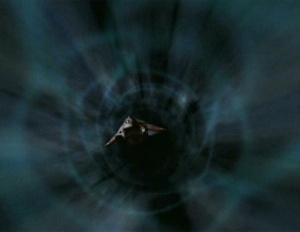Difference between revisions of "Quantum Slipstream Drive"
m |
m |
||
| Line 16: | Line 16: | ||
! colspan="5" | | ! colspan="5" | | ||
|- | |- | ||
| − | |'''VELOCITY ([[ | + | |'''VELOCITY ([[Warp Factor|WF]] EQUIVALENT)''' || '''x LIGHT-SPEED''' || '''TO NEAR STAR''' || '''ACROSS SECTOR''' |
|- | |- | ||
| Warp 11 || 32,561 || 1.3 Hours || 5.4 Hours | | Warp 11 || 32,561 || 1.3 Hours || 5.4 Hours | ||
Revision as of 19:34, 12 February 2019
The quantum slipstream drive is an advanced form of interstellar propulsion that achieved and exceeded what failed Federation attempts using transwarp were meant to do: exceed the warp speed barrier. Originally developed by an advanced species native to the Delta Quadrant, the technology was obtained by the USS Voyager in 2374 and used for an aborted test in early 2375 that nearly destroyed the ship.
The slipstream is a narrowly-focused, directed warp field that is initiated by manipulating the fabric of the space-time continuum at the quantum level. It works by focusing a quantum field through a deflector dish to generate massive changes in local space curvature; this creates a subspace tunnel, which is projected in front of the vessel. Once a ship has entered this tunnel, the forces inside propel it at incredible speed. In order to maintain the slipstream a ship has to constantly modify the quantum field with its deflector dish; however, the calculations involved were too complicated for 24th century Star Fleet technology, and the time available was too short before the vessel out-paces the tunnel, collapsing the slipstream.
By 2415, thanks to decades of increased military spending, Star Fleet believed they had cracked the mystery of Slipstream Drive: generating the slipstream corridors required more processing power than forming warp fields; the computational power required is directly related to the frontal geometry of a vessel and lesser to the ship geometry. Therefore, slipstream propelled ships are generally narrow and compact with aerodynamic lines. However, they are also more energy-efficient than warp drive. The first tests had not taken geometry into account and failed, sometimes spectacularly, but the first Slip Vessel to successfully maintain a slipstream corridor was launched in 2416.
The first ships to receive Slipstream Drive were the Vesta Class Explorers, but Star Fleet has plans to gradually phase out older designs and replace them with newer Slipstream-capable vessels.
Slipstream Velocity Scale
| VELOCITY (WF EQUIVALENT) | x LIGHT-SPEED | TO NEAR STAR | ACROSS SECTOR | |
| Warp 11 | 32,561 | 1.3 Hours | 5.4 Hours | |
| Warp 12 | 47,474 | 55 Minutes | 3.7 Hours | |
| Warp 13 | 67,156 | 39 Minutes | 2.6 Hours | |
| Warp 14 | 92,588 | 28 Minutes | 2 Hours | |
| Warp 15 | 124,852 | 21 Minutes | 1.4 Hours | |
| Warp 16 | 165,140 | 16 Minutes | 1 Hour | |
| Warp 17 | 214,756 | 12 Minutes | 49 Minutes | |
| Warp 18 | 275,115 | 9 Minutes | 38 Minutes | |
| Warp 19 | 347,749 | 7 Minutes | 30 Minutes | |
| Warp 20 | Infinite | 0 | 0 | |
